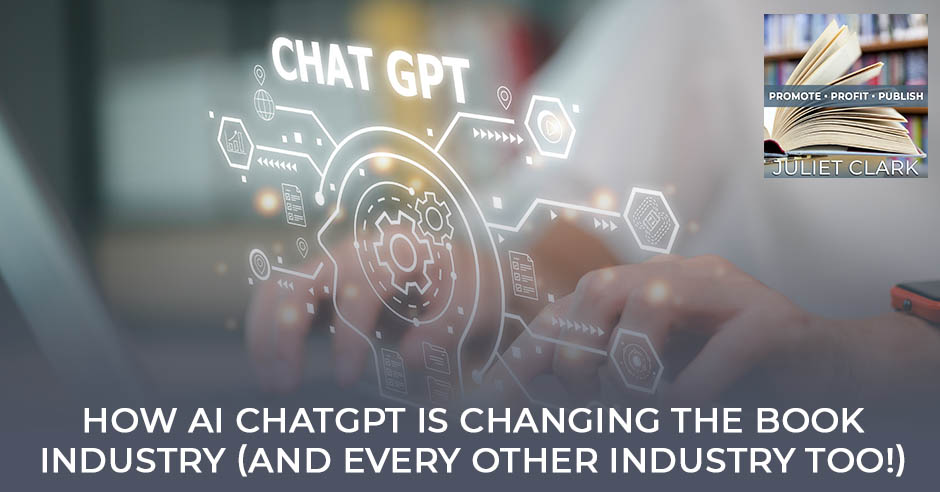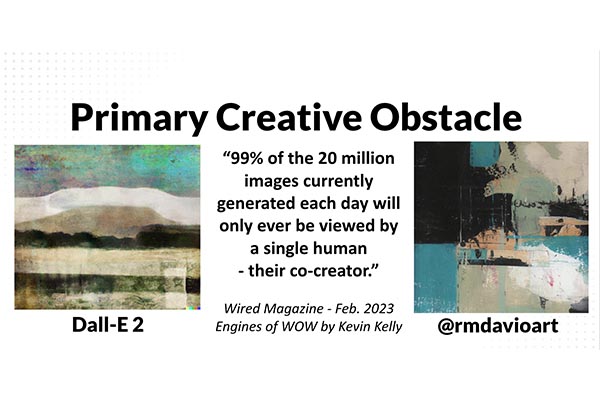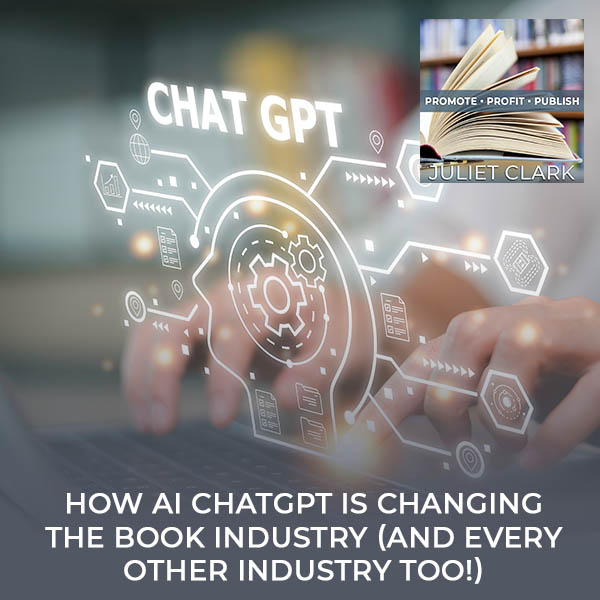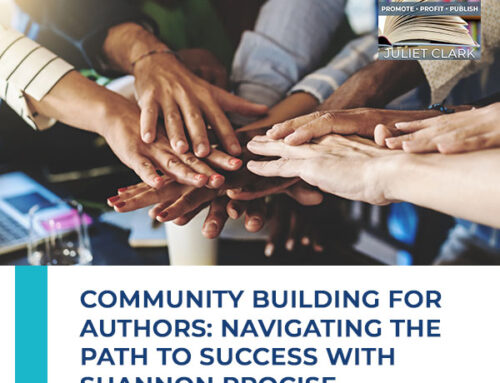
It is scary to think how Artificial Intelligence tends to replace people in their field of expertise. In some cases, AI creates better work than humans. But should we let AI bother us today? In this episode, seasoned media expert and host of The Binge Factor, Tracy Hazzard, dives into how AI ChatGPT is changing the book industry and other industries as well. Although AI may lack the emotion that writers could bring in their work, could it still write better than humans? Tracy turns those fears around and goes deep into why everyone can embrace AI. She shares how it can be a tool to unload other tasks that we are better off not doing, so we can focus on what we do best. Tune in to this episode to understand the value this technology can bring for the artists.
—
Watch the episode here
Listen to the podcast here
How AI CHATGPT Is Changing The Book Industry (And Every Other Industry Too!)
This is the 250th episode of the show. I’m super excited. For those of you who were on earlier, I never would’ve envisioned that I started this in 2018 and would get this many in. I’m super excited to have Tracy Hazzard on. Tracy is a seasoned media expert with over 2,600 interviews from articles in Authority Magazine, BuzzFeed and her Inc. magazine column and from her multiple top-ranked video casts and podcasts like The Binge Factor and Feed Your Brand, one of the CIO’s Top 26 Entrepreneurial Podcasts.
Tracy brings diverse views on what works and what doesn’t work in marketing, branding, and media from thought leaders and industry icons, redefining success around the globe. Her unique gift to the podcasting, marketing and branding world is being able to identify the unique binge-able factor, the thing that makes people come back again and again, actively listen and share you as a raving fan base.
Tracy, welcome. I’m super excited to have her because we had a big AI call. Tracy put it together. It was interesting to hear people from diverse entrepreneurial areas come together to talk about how they used AI. There were a couple of things that Tracy shared about her own company. They’ve been using it for years. She’s my go-to person to pick brains about, “That sounds too technical. Thank you for sharing,” because I’m not a tech person. I’m excited to have you here. Tell us what you’re going to talk about.
AI is the talk of the town. However, the reality is that there’s a lot of talk and in use a lot. Let’s talk about some of that and ways in which it’s disrupting industries because it is going to. I have an entire team of copywriters, graphic designers, video editors and audio editors. I have over 80 staff members around the world. They are going to get their jobs disrupted whether they like it or not. It doesn’t matter whether they embrace AI. They’re going to be out of a job if they don’t understand how it’s going to impact their job either embrace it as a part of the process, or train and learn on it.
One of my favorite movies and we watch it all the time is called Hidden Figures. It’s about space. Tom and I are kind of space geeks. It’s about the women who were called the computers. That’s what they were called. The Black women were called the computers back in NASA days. They did all the mathematical calculations. This giant IBM machine shows up in the building one day. The manager of the department looks at it and says, “We’re going to be in trouble.” She teaches them all Fortranm and code. Not just mathematical calculations, but she teaches them how to code because she says that beast in there is going to need a bunch of coders and they’re not going to know what to do with it. Sure enough, not only did she get all the Black women’s jobs, but White women’s jobs too.
She did her thing there by transitioning the company. That’s what I keep saying to my staff. I say, “I want you to be a part of the solution. How are we going to use it? What is our job going to look like? What’s the standard operating procedure going to change? With AI in the process, how can we make it our own and do something with it so that you’re a part of that future and your job is guaranteed? Hopefully, your job is less boring. It’s more interesting and exciting.”
I don’t think we’re going to get rid of proofreaders. That’s my number one example here. People think that they can have AI proofread it, but the problem is that the large language model that it’s trained on has as bad a spelling as the rest of the world. It’s not going to be any better at proofreading. It doesn’t understand whether or not that’s right or wrong unless it’s truly been trained on the proper dictionaries and all of those things. Its rules are taught to hold fast to that first and foremost, which means that it will get rid of the vernacular very quickly. Now you’ll lose tone. You might trade off spelling for tone. These are the things that are a struggle in an industry that’s going to have to figure out before we can trust that proofreading can happen in any format, article and anything we do. That’s an interesting thought, thinking about it from that perspective.
That’s where the Bill O’Reilly analogy came in. He was on the show and said they gave the ChatGPT some facts and said, “Go write a Bill O’Reilly-style blog about this.” It had all the facts and figures, but it didn’t sound like it came from Bill O’Reilly. There was no humor or sarcasm. All of that was missing, which is an important part of what his audience loves about him. It’s his tone.
I’m going to explain why because Bill is a primary TV person. The large language model is on the written word. Unless he has more articles than he has videos, the large language model can’t learn his tone and style. He’s not known by the computer. That’s the difference right there. You mentioned I have over 2,600 articles and interviews that I’ve done. Of those 2,600 interviews, every single one is a blog that is over 3,000 words.
For an AI to learn my tone is a lot easier because of the model of how I’ve developed it. It fits in their system better. That’s what we have to do better. If we want it to learn us, customized to our brand and get our voice, we have to give it the data that it requires in the format that it requires because the large language models that it’s trained on were Twitter and Reddit. I don’t know that I want anything I write to sound like that.
One hundred and forty characters.
It was also trained on broadcast media but not video. It was trained on audio transcripts. Radio transcripts, if you want to think about it, because it’s old school because they used old data. It was trained on anything that was written down, from the newspapers or magazines, but anything that got eventually transferred into a database of information. That’s what it was completely trained on. That’s predominantly White male right there.
Bill O’Reilly is lucky. It probably would get him better than it would get me, but luckily I have enough. What enough is is the real problem here. We think, “I’ll give it a few chapters in my book and it’ll get my tone.” That’s not enough. We think we found the tipping point is about 50 articles over 3,000 characters. Somewhere around 100,000 characters rather, if you want to think about that. That’s somewhere around 50,000 words, which in the book is doable. If you put an entire book in it, it can learn it. That’s enough for it to learn you. If you had one book and you’re writing your next one and you want it to get the same tone, it would get it. It’s enough, but you have to feed it that information in the beginning. You have to teach it to learn from.
I know a lot of people are using it for research and you said something interesting to me the last time we talked about, “You have to be careful with research because ChatGPT stopped at December 21, 2021.” Talk a little bit about that. I know students are trying to use it to cheat on their papers and stuff like that, but they don’t realize that they stopped it, and do you know why?
They did it as guardrails because you don’t want to mess in elections, current politics and something that’s a current event that’s unfolding and you don’t necessarily know how the case resolved itself in court if you’re talking about legal findings. They stopped it at a point at which they could say, “We have all this history that you can pull from.” It was a guardrail because, remember, ChatGPT was not meant to be utilized for your end purpose. It was meant to be brute force tested by the general public. They needed to see what people would ask it so they could decide what format to turn it into something. What resulting business models were they going to use from it? That’s its purpose.

AI CHATGPT: ChatGPT was not meant to be utilized for your end purpose. It was meant to be brute force tested by the general public.
People think, “It is an end thing in itself,” but it’s not. It was the next phase of research, if you want to think of it that way from themselves. They put some guardrails on it so that people wouldn’t get distracted by what was going on, but also that would do a little bit less harm if things weren’t resolved in what was going on. That’s why it’s there. The reality is it’s lucky for most students, their textbooks are older than 2021. They’ll probably be fine.
I never thought about that. There are a lot of old stuff out there. Let’s talk a little bit about how writers, authors and book developers can use this. I know through my testing it’s great for marketing. It can write some incredible copy if you let it.
Think about why that is. When I was talking about the large language model that it’s trained on, most of the stuff we see in the written word that’s out there on the internet for it to train from is marketing promotion in some way, shape or form. That’s also key to what’s happening there. Another side of that is behind-the-scenes, the Whisper.ai, which is the transcription model that it utilizes, how it transcribes things and how it interprets the next word that’s going to be said also had Microsoft in the process there. Microsoft was a large investor in that, but they also contributed in kind their machines, know-how and information.
There was always a transcription system within Microsoft Word. I don’t have an actual fact on it, but I suspect that they fed its model of information that came through that transcription as well. Legal language is a little more accustomed to marketing language because we write emails all the time. If you think about that, it learned from those things as well because how many people in the business world would’ve used that to dictate the email that they were going to have written?
There’s a lot of information on that. That’s why it’s better at writing those than it is, let’s say, writing a chapter. That’s where it can be very useful in doing this. I did this because I joked about it and I thought, “If I joke about it, then I should do it.” My daughter joined the pep squad at the high school she’s going to go to. I decided to join the financial management team because, for some reason, the pep squad’s the only athletic group that gets no funding from the district and I’m going to get to the bottom of it so that us parents have to do less work to fundraise for them.
You know me enough to know that that will happen in the next few years whether they like it or not. They should cave now. I figured, “They were writing this email and weren’t getting the parents to make their donation fast enough that they could determine, ‘Can the girls go to a camp this summer?’” I was like, “Here’s the email that they’ve been sending. ChatGPT, what do you think? How can we make it more urgent? How can we make them donate faster?”
Sure enough, it came with a headline. The rest of it wasn’t bad. It made some minor changes, but the headline adjustment and we sent it out and donations were already flowing in. It must be working and that’s a good thing. That’s because it has the data to give you the results you want. That’s what we need to be clear about. Sometimes it doesn’t add the data we want. We get these results. We look at it and think, “That must be all there is.” That’s not true. We all know that. You need to sit back and think about that and saying, “That’s not what I want. How can I get what I want? Can I feed it some things to help me get better at what I want? Can I direct it in a better way?” Most people don’t have the patience for that kind of level of repeated request.
Now we all know that Tracy doesn’t like to go door-to-door selling candy bars because let’s face it there, our children never do it. We have to.
I call it the non-fundraiser fundraiser. If they send me that, I’m going to write a check. There’s no fundraising and fun in that. No, it’s, “I’m going to write a check and be done with this.”
Let’s move on to books because I think this is where you and I had the biggest conversation about this. Readers, me and Tracy did an AI call with a bunch of entrepreneurs from different industries. One of the guys there mentioned that he wrote this amazing book with AI. He was selling it for $38. I went over to PayPal and bought it, as did the other publisher who was on the call, because we wanted to get a flavor for this amazing book.
I didn’t get my copy, but the other publisher shared with me that it was not so amazing. We still need book developers because you can get all of that writing done, but it has not only no voice, but it’s almost from what the other publisher told me, robotic in a sense like it’s not engaging. Can you talk a little bit about that? I’m sure we’ve got two book developers on. They’re probably like, “Thank you, ChatGPT. I’m still in business.”
There are very few full books in the model of it, but if you go on Amazon, there are about 200 books stating that it was co-written by ChatGPT. Evidently, that’s an author category now. There are a few issues with that. You can’t give it an outline and ask it to write that when it has no sense of what you want. If this is supposed to be your ghostwritten book, then it needs to understand your perspective.
I’m lucky. Honestly, my ghostwriter has been using AI for a long time because Jasper.ai has been around for a while. Sometimes I’ll have articles, but the articles come from my podcast, my voice and my perspective on something. It’s already starting from the right place. That’s what a lot of these are missing. It says, “Write me a book about this.” That’s no better than using some kind of Romanian farm to write your articles for your online publications.
I can tell you that I know companies that built entire websites off of Romanian writing farms. All they did was write articles that sounded like everything else on the internet. This was pre-AI. Somebody was writing it, but all they were doing was skirting plagiarism. They were finding out how many other articles on this particular topic and keywords are out there then taking enough from it and changing enough to make sure that it wouldn’t be flagged by Google as plagiarism because we don’t want something that downgrades the website at the end of the day. That would be dangerous for them.
That’s what they were doing already. It already ha has a model. If a human can do it, the bot can do it faster. There’s no question about that. That’s what these books are like when you do them in this way. I think there’s a great way to be using it to come up with better titles or chapter flow. There are ways to feed things into it to help you do your job better as a book writer, book publisher or editor. All of those things are there for you.
There are ways to feed things into AI to help you do your job better as a book writer, book publisher, or editor. Share on XWhen I sit down to write, I don’t write at a fourth-grade level. I write at a college level. That’s not great for readers. If I took my chapter and said, “Please make this simpler to understand for non-techies,” wouldn’t that be a great way for it to run a pass through it and clean that up? I’m not asking it to change my message. Thought leadership is not going to come from artificial intelligence. It can only follow because it must use what it’s got. If you want to be a thought leader, you’re not writing a book in AI. It’s not happening there.
Are you smart enough to use it to take some ease off of you and make a first pass of proofreading? That’s okay to let it do that. Check these things or maybe even out your tone. Tense. How many times do poor editors have to fix the tenses that you use, past tense, future tenses or whatever that is? It’s a pain. I would rather send it to the AI and say, “Put it all in the present tense,” have it fixed for you and then start from there. That way, your time is more useful on the important things like giving it humor, and tone and making sure the message is there and the flow between chapters is happening because that’s the most critical part of being a good book.
I read 300 books a year. There’s a must-human-written crap as there is AI-written crap. I guarantee it is out there. I read some bad books that I swear no human should be allowed to write. It can happen in both ways, but we need to use it in the places where it can do the most good to make our jobs easier. We can be the beautiful humans that we are and bring thoughts, direction and things that we’ve learned only from years and years of experience. I would rather have an experienced book editor looking at my book than I would have an AI who’s only done it for three months.
To me, it’s like using spellcheck on Word. It misses things. I noticed that a lot. My editor is probably too polite to tell you I’m a crappy writer. I’m a good storyteller, but I’m not a great writer. You would think owning a publishing company that I would get proof. She has to do like a deep dive edit on every single thing. You’re probably all going to get off the show now like, “She’s not as wonderful as I thought she was.”
The other thing we have to remember is that at the end of the day, if we use ChatGPT to write it and not enough of our own in there, there’s no copyright.
That is what I was going right into because I’m seeing this all over the music world right now with not only the material but the voice that is a copyright violation. Is there a legal amount where if it’s GPT written, you can’t apply for a copyright? How do I get my authors to cop to it?
That’s the big key here. You can clearly tell if a musician didn’t author it themselves and somebody else is doing it in the style of. That’s a clear violation of more than copyright. Those are going to fight themselves out in court. We already have enough problems. Ed Sheeran’s in court fighting for musicians to learn from the ether of what’s music out there because there are only many courts. There are only many words we’re going to put together in a pattern. I do hope he prevails here.
He did. He won.
He was going to literally go to quit on his tour if he lost this because the courts were wrong. They were wrong on a couple of other cases that they’ve already ruled on. I come from the design world. We used to have to put derivatives and define it in our contract. If I designed an office chair, which I designed a lot of those, and I designed it for a company and they were selling it in Costco month after month, it was making me royalties and they decide without my involvement that they’re going to change the color or material of the chair, they could think that they don’t have to pay me royalties anymore. They used somebody else in something internal and they made an internal decision because the materials across a good 80% of the chair visually they were like, “That’s a big change. We don’t have to pay them.”
We had to define in our contract that color material changes don’t count as their derivatives of the original design. You have to make more than a 10% adjustment on every single face or side of the product, whatever that might be. In a 360, you’ll end up with a minimum of 40%, but in some cases, it’ll be closer to 60% changes. That’s how much we defined. Anything under that was a derivative and you still had to pay us royalty. We had to define it in our contract because the courts don’t do a great job at defining it until they see the end product and then they have to fight it out to figure it out. That’s what we’re going into here.
The same thing’s going to happen with ChatGPT. The real problem is if you’ve used something like Grammarly or Linguix, the checkers out there will flag you as having been written by a bot even if you didn’t. It’s because you’ve overly robotized your language pattern by using the grammar checks. It can also do a false reading on it. You don’t have a good tool yet for us to tell what was written by the AI. At some point, they’ll probably require it to put a code in there that will be an indicator that it was used in any way, shape or form. How much percentage? That’s where we’re then going to fight it out.
Looking at that, what we don’t want to have to happen is that we use ChatGPT or Google Bard, which I like a little better. It does a slightly better job on marketing materials because it’s spotter. It has more of the internet rated and ranked, so it knows what’s more authoritative. It already has a model for that because that was information that you couldn’t scrape from getting all the information that Google has. I can’t scrape all those websites and understand the model of how Google’s already ranked them, but Google already understands that. Its AI is a little smarter on that side of things.
I can see that somebody could scrape and try to write something like me, but at the end of the day, we’re going to know the difference. I’m going to definitely know the difference. It’s my job to keep my voice out there. It’s my job to keep doing that as a thought leader. That’s the difference. That’s the struggle that we have to get in our entrepreneurial mindset. Our job is to not do the route of letting the AI write it, of making sure that we’re bringing our unique voice and perspectives out to the world and using these tools to make it go faster and easier.

AI CHATGPT: Our job is to not do the route of letting the AI write our book, of making sure that we’re bringing our unique voice and perspectives out to the world and using these tools to make it go faster and easier.
I have tested ChatGPT. One of the advantages is they have a ton of training over there. If you want to use that, it’s $20 a month and go over and do that. There’s training on how to use it on different things. I’ve also used Jasper.ai. The benefit, if you’re a beginner with Jasper, it is more expensive but it has categories like looking for an Amazon headline. You can get more finite in what you’re trying to create with Jasper.ai. If I was going to encourage you guys to play with it a little bit, I would spend a couple of months paying the higher price on Jasper first and figuring out what different things you need from it and seeing if you can do some training over on ChatGPT.
One thing that I want to mention is what they’ve already done on Jasper is created the pre-prompts and that’s where you need to understand. Not only is it trained on a large language model, which is basically all the information that it’s learned patterns of how to do things. It also can reaccess that in whatever you ask it for. What you ask it for is called the prompt. You’re prompting it to do something. You can do a prompt that builds. For instance, we already have a prompt that is pre-written for my podcast specifically.
It’s going to title my podcast episode, but it’s already pre-programmed and knows the 200 other ones that I have in there. It understands all the titles I’ve liked already. It gets what I’m going to accept. It starts to learn the pattern of my sarcasm, humor and style from that. We’ve already pre-fed it in there. The next thing we do is tell it exactly how long it needs to be. We’ve given it all the data. Jasper already did that work for you. What’s an ideal Amazon headline? You don’t have to know the exact character link to make that right. It’s going to come up with it for you.
They’ve done this pre-prompting. When you do and put your request in for the stuff that you do want to know like, “Give me a title for this,” it’s going to go out and already have that stuff constraining it. You don’t have to figure it out and then ask it to do it after the fact. It’s going to save you. It costs you a little more, but it’s going to save you a ton of money in time.
I saw some copies. One of my clients brought me one yes copy that she did for an upcoming challenge over on ChatGPT, and it did a good job. Here’s the other thing you need to know as a novice. She had her branding marketing expert put in the parameters. If you’re a layman and you don’t understand what you need behind marketing, you may not get a product as specific and fabulous. It was a good copy. I noticed that too. Sometimes if I don’t put in directions that are finite enough, I get an answer back and I can look at it and go, “That’s crap. I wouldn’t even write something that bad.”
Think of it like our kids. The first time we tell them to clean up their room, they shove everything under the bed. The next time you ask them to clean up your room, you say, “You clean up your room. I want everything off the floor and not under your bed.” You are clearer the next time. That’s the part that most people lose patience and they don’t continue to retrain it until you get your prompts refined that now I can type it in, copy and paste everything but then give it the new text that it’s going to build a title from. That’s it because I already have that refined and perfected for me.
When you go in to use ChatGPT, they have multiple conversations going. One of the key things is that it doesn’t learn between the conversations. Most people don’t realize that. If you’re titling episodes like I am, I have one section and conversation section that I continually do it in because it’s going to keep learning when I keep it within there. If I jump around and make a new one, like a logical thing is it’s like, “I’m going to do chapter 1 here, then 2 and 3 here.”
If you do it that way, it doesn’t refer to each other. If you want to know why your chapters aren’t flowing, that’s exactly why. It’s how we use it. That is why you want to use the more expensive versions that you can get the training because it gives you this logic of use and helps you understand how it’s working and have the patience to go back and forth and do it. One of the things that I like about Google Bard is that it does have a feedback loop at the very end, which is, “Was this a good result or not?” All you got to do is give it a thumbs or down. You don’t have to make it more complicated than that.
By telling it that you walked away with the answer you wanted is critically important because there was a statistic in the WIRED magazine that said DALL.E, which is the image generator. You type in a bunch of texts and it generates an image in the style of Rembrandt or something like that. An image in the style of Ansel Adams, a photograph in that style, you can do it that way. Ninety-nine percent of the images will never be seen by a human outside of the person that asked for it within the image creator.
Telling the AI that you walked away with the answer you wanted is critically important. Share on XOnly 1% of those images are ever going to make it on Instagram, a book cover or outside of the image creator software. The reason is because it’s not good enough, but they’re not telling it that it’s not good enough. They do it and walk away. If we at some point don’t say, “None of these were good enough,” they will never learn. That’s a key factor here that sometimes the feedback loop has not been learned.
To go back to those separate conversations, I wrote using ChatGPT to go get information about the Promote Profit Publish Podcast. I was showing Kevin Jones, one of my clients. I was like, “Look at this. This looks impressive.” If you read my blog, I don’t think it’s impressive at all. That’s me being humble. It was funny because we went in right afterward and we pulled a piece of his website that he didn’t like. We said, “Let’s go in and rewrite this.” When we rewrote it, it pulled in that like I was a part of it, Juliet Clark Promote Profit Publish because it was learning from that previous. You do have to be careful to stop it or you’re going to get some things in there that you don’t like.
As with us humans, it can become templatized. We have to be also careful about that and make sure we’re mixing it up. There are a lot of AIs in the podcasting industry who recreate descriptions and summaries of the episodes. I can look at one on the podcast app and say, “I know they use this tool.” They don’t realize it within themselves because they do an episode a week. It’s not enough in a row for them to see the pattern that they all look the same.

AI CHATGPT: As with us humans, writing can become templatized. We have to be also careful about that and make sure we’re mixing it up.
When you get 250 episodes in and they all start to sound exactly the same, like it says in this episode, “Juliet talks with Tracy about this,” and you can see there’s a pattern of how it created that because it will go the lazy route. Just like us humans do, it’ll go the fast route and it was like, “This human likes this so I’m going to give it to him again.” When you don’t go push back and say, “That sounds like everything else you’ve done,” it’s not going to correct itself. It’s not going to make itself. It is not going to give you a variety.
Now you have an extra employee you can fire because they’re lazy.
You can at least yell at it and you know there’s no liability.
Almost everybody on here is an entrepreneur. How do we incorporate that into my business besides using ChatGPT if I wanted to automate something or I wanted to change? I know you guys have done a lot of this and my initial when I came to your call was I’d love to get rid of my formatters. Do you have to learn code? How does that work if you don’t know how to do this?
There’ll be those people out there and usually are already experienced coders and they’ll be like, “Ask ChatGPT to code it for you.” it doesn’t work like that. The difficult part is that some of the APIs and API is basically a coding automation that allows my software or system to communicate with ChatGPT, go back and forth and deliver information. Those APIs aren’t all the way gelled. They’re not complete. There are some that are coming in and then others that are coming in way too expensive. If you were to use these API, every time you go back and forth and ask for information, you’re paying for it in both directions and it’s costing you lots and lots of money.
For instance, transcriptions. We use an AI transcription software that we’ve been using since 2018, but we put it on our system and incorporate it. We use very little of the API piece. We’d use it to keep the large language model up and running. I don’t think we even spend $5,000 a year on it. Considering we do about 50,000 episodes a year, that’s good. If you think about running your transcriptions out there, you can’t do it for that price.
We’ve got that built into our system through a combination of API and custom code. That’s what you’re going to need to do here. We’re looking at the same thing with luckily for us Whisper.ai, which is the transcription system that is part of OpenAI, which is ChatGPT, essentially, is open code because the company is an open-source company. We can take the code without ever using their API, but we have to develop our own software on top of it.
That’s the key here that most companies don’t have. There is a lot of automation coming. There’s a cool one that I tested out called Opus. Opus Clip allows you to put a YouTube video in and have it give you the clips you should use. That’s a workflow process. It’s not integrated where it’s going to go and connect up to my backend and be able to do it for every single episode automatically or anything like that.
You have to develop a joint partnership with a company, then develop an API code, your custom code, interact with it, generate it, pull it, give it to your clients, whatever you’re going to do. It’s a lot more complex. That’s where most companies say we’re using AI and we only see companies like Zoom, ClickUp, Salesforce and big companies who’ve incorporated already because they already had the coding teams in place to be able to do that. It’s going to take us smaller companies longer to develop those.
I luckily have a coding team too, but mine still only has much bandwidth and we’re doing the stuff that is more important day-to-day than it is adding these things in. We use it behind the scenes, test it, get it right, get the flow going with human beings and then when we figure it out, we say, “Now we’re ready to code this, incorporate this and automate that.” There are many other companies that you could make it as a part of your flow. You jump into a Jasper and you do this and you write a protocol for it. You have a staff member that does. That’s still reasonable, cost and time effective for any entrepreneur to do.
We interviewed someone from Australia that is a copywriter. He showed me in Dropbox what they put together and it was very interesting to watch the flow that they had coded and then put in Dropbox. I think Dropbox has some automation that takes part of it from there. I know I have a Dropbox AI in mine that I haven’t figured out how to use yet.
Mine just popped up. I recorded a quick little training video for my team. It popped up the AI and the top said, “Would you like to take out your filler words?” It lets you automatically edit them out of your video. All your ums and ahs. I use the word so a lot as I’m thinking, “So we should do this next.” That’s my filler word. It suggested those.
I like my filler words.
It makes us us. Imagine cutting that out of a video and what do you have is it’s a jump cut. How much more disjointed is it to watch a video that you’re like, “What’d I miss? What’d they take out? What happened there?” We, as humans, won’t accept that as easily.
It’s the neuroscience behind what your mind sees there. There’s a li very limited amount of time to process. It’s like watching a badly or poorly edited movie. It can be distracting from the actual story in the movie when you see things like that.
I have a question. Let’s say we have an author and we want to create an experience where the reader can ask questions to the author and have an actual dialogue. What are your thoughts about that? Anything you’ve seen in that direction and how would you accomplish that with the current platform?
Is the author there or is it a bot on the other side?
If you made it a bot.
The author doesn’t have to be there. The most important thing is that you have enough of a language model for that author. You want to do something where you’re doing lots of interviews of them, Q&As and you’ve got an experience to how they answer things so that there not only is the database of, “What’s in my book?” so they answer that properly, but, “What is my pattern of language that I use when I answer questions so that it will sound a lot more like me?”
What you pre-program into it is as important as how it’s going to function on the other side. There are a lot of chatbots that function fine on the other side of it, but they’re functionally set to a personality already. You’re going to have to find one where you can train its tone and personality. They are coming because there’s a lot of customer service once coming out that are going to be trainable that it sounds like your company when they answer.
What you pre-program into the bot is as important as how it's going to function on the other side. Share on XLet’s say the author is Deepak Chopra. There’s a ton of content out there to feed into it, but let’s say it’s a new author that hasn’t put much out there. Would you go with the author and ask every possible question that somebody may ask and have all that?
Do an interview and make it a part of the process or the package that you offer them. You maybe even have an arrangement with three different podcasters that are going to take a different take on it. You already have it. It’s part of your marketing plan and they’re already going to do it and you’re going to take those and program them into the bot.
Here’s the other thing, build their platform and then they’d have plenty of content. They should be doing that anyway. That is all that stuff to feed in. You don’t have to rush out and create it.
It’s enough to feed a new author.
If you want to do an amazing job of getting them, you need about 50 pieces of content. It’s like anything that’s 20 to 30 minutes which should be a real piece of content. That’s enough content with questions and answers because you’ll ask about eight questions or so in that amount of time, so 5 long ones or 8 short ones. That’s about the amount of time in 30 minutes you can do that. If you did that, you would have enough questions and answers to get through that. If you’re going to do a model of, “I needed to get the answer to the question, it doesn’t have to get the author as well,” you can do it with about twenty. You can do about half.
I am working with small businesses. It could be a hair salon or a chiropractor, or local businesses, maybe even up to mid-size. I wonder if there are going to be any copyright issues because they’re ideal. A hair salon doesn’t have a copywriter sitting there, but they still have to put up websites and things. I’m wondering if there are any hidden issues with small businesses using artificial intelligence.
There isn’t. The European Union has come out saying it needs to be marked, but they’re more concerned about right now what the large language model ChatGPT used is infringing existing copyright than they are worried about our output use of it. Right now, it’s still very human-guided. In that human-guided model where I’m telling it what I want it to write about and what I want it to do, there’s still enough of me in there that they’re not going to be able to figure out how much came from outside and inside. We have the same problem already with ghostwritten content. You’re not fessing up to your ghostwriter. I tell everyone who mine is. It doesn’t matter to me because I don’t have the ego on that side of it, but we don’t do that in the world very often.
We don’t fess up to who the real ghostwriter is. Is it your copyright? It’s not at the end of the day, but it is your information, story and content. As long as this doesn’t become a cookie cutter, it’s got the exact same words on this chiropractor’s website that is on one that’s on the other side of the country, then we’re not going to run into trouble. We don’t want to do that anyway because it’s not a formula for winning on the internet.
If you have duplicate content, it’s not going to win. Bringing enough of it and making sure that your process allows you to pull out why this hairstylist is amazing, why this chiropractor is amazing, that’s going to be enough to give them what they need right there in the world. It’s going to make it easier, honestly, because a lot of them don’t have the time to articulate everything. You’re going to have to work with a smaller set of information and make it sound amazing.
I know if I put duplicate content on, Google doesn’t like it.
They used to red-flag your website. Now what they do is they say, “That article first appeared on Tracy’s website. Second, appeared on Juliet’s website.” Juliet doesn’t get the ranking for it, but I do because I was first. It’s gotten smarter in how it does it, but we used to do something behind the scenes and I still recommend it because I think it’s much better for the way the ranking system works. It’s to do something. If you want to republish somebody’s thing, article, podcast or anything like that, that’s republished, do it no index and no follow.
It’s the setting that you set in the blog when you put it behind the scenes. If you do that, you’ll never have an issue because you might want the content because it’s important to your website visitors, but you don’t want to have the penalty of having that content there. Sometimes we have to have things for user-friendly reasons and other times, we have things that make us higher rankings in Google. We have to play the game. I call it being bought worthy. Our websites or books have to be bought worthy from their titles and descriptions or Amazon, they’ll never show up. We have to play the digital game. Who better to play the digital game than an AI already who understands it better than I do?
When we have contributors to our magazine, we insist that the articles are original for that reason. We don’t want duplications that they’ve published someplace else.
For something simple like a hairdresser, if I’m looking for one in Fallbrook and there’s one in New York that has the same wording, is that in a penalty? They’re very geographical. I wouldn’t be looking for one in New York.
It is still because the internet is the internet and it doesn’t know where anyone’s located. I mean it does know at the end of the day where they’re located, but it doesn’t do that. It cannot have the exact same wording. It does have to have a mix-up of the wording. The same style of message, no problem. If that impact happens, that’s okay, but it does need to have different actual wording in it in order for it not to be considered a duplicate website. The one who puts theirs up second will lose. That’s why there are many people out there who still do search engine optimization. That’s the stuff that they fix.
Speaking of cover art, like art for the cover of books, I do think there’s going to be a large amount of AI happening in that. We already have image issues. You can have a hard time getting photographers to do what you’re looking for. Finding royalty-free art that you can use and getting the right type of license to do it. It’s got a lot of friction in the process. I see that as a big loser in the AI world because if I can go into the chat and say, “Give me a mashup of this and this, and then make it look a little bit mysterious or ominous because my book is a mystery,” wouldn’t that be great? I could get exactly what I want without hiring a photographer or a designer.
The only thing I do need to do is lay out the rest of the book, but by laying out my title on it and everything, I have created something, even though the image underneath it is not copyrightable. By adding my title and all of that, I’ve created a copyrightable book cover. I’ve accomplished what I needed with a lot less difficulty. I do see that in the book world. I see that as happening and going to be coming out because how often do you get something and you go, “I wish it was red.” You can’t change those things. There’s too much difficulty to get the right designer to do it and then it doesn’t always look right. These machines are capable of doing a lot of that.
I know some of you are from Jared’s group and you’re going to see my presentation on publishing prep. I’m going to show you the funniest thing where we wanted an example for a designer. You have to remember that when you design it, it’s coming from your head into my head and then I’m telling a designer what we want. We had where we wanted it to be racy. It was a book on secrets, Break Free Of Your Dirty Little Secrets.
We wanted it to be racy and fun. We got this thing backed and we couldn’t figure out if it was erotic fiction or what. It was racy, but it wasn’t something that you would put in a self-help book. I think that’ll be a big help for you guys getting that preliminary artwork because it’s helpful when you show up with a mockup of what you want. When I send it off to the actual designer, we have a good idea of what you want.
I have an Arts degree. I got asked to talk to my alma mater about AI here. The reality is that, as designers, our fees are low. For us to truly be creative, there’s not the time or the money for that to happen in the process. We’re not paying for that. We’re paying for mechanical output. If you can give creative direction in any way, shape, or form better than the next person, you are going to get such great results because my artistic mind is going to be able to go off and then I’m going to be able to add to that, build on that and give you when I see the brilliance of what it is. Otherwise, I don’t have the time or the money to guess. I can’t figure out I’m not you.

AI CHATGPT: The reality is that, as designers, our fees are low. For us to truly be creative, there’s not the time or the money for that to happen in the process.
We have an amazing artist on here. Anne Wall has a beautiful book and paintings she sells. Have you used AI at all within the art world?
No. In fact, I only started using ChatGPT just to experiment with it. Your webinar here was very timely.
Go in and try DALL.E. It’s a part of the open AI system and you can log into it separately. It’s completely free. There’s nothing to do there but play in there. My mom is a fine artist. She’s an abstract artist out of Laguna Beach, California. She has got beautiful, amazing work. I ran this test to present it at an event where I took the exact description she puts on the plaque on the wall at the gallery. I took her exact description and the title of her piece, and then the materials on the cover. I knew it was the acrylics and collages. I gave it a description of the medium and a description of the color direction. It was like teals, greens and things like that.
I put that in and said, “I want to create an abstract art that does this that could be used in a kitchen.” I made that part up. I gave all of that together and I showed them side by side. There’s a clear difference that my mother’s art is so much better. It’s a photograph of her art, not what you’re experiencing in person. The digital version that they created without ever seeing her is fairly scary close.
When we think about that from that perspective, most people don’t have the art understanding to know that it’s flat. At the end of the day, you would know in a minute which one’s real and digitally created. That’s what I’d asked without showing them. You would know instantly, but your average person cannot tell the difference. That’s the scary part about what’s happening here, especially if it’s learning off all of your art in galleries everywhere and didn’t get permission for it.
I found the AI writing to be scary because it was writing better than I am. The part that we all need to keep in mind, whether it’s art or writing, is if we can infuse emotion into it, AI at this point can’t do that.
The part that we all need to keep in mind, whether it's art or writing, is if we can infuse emotion into it. AI, at this point, can't do that. Share on XTracy, thank you so much for being on. Guys, thank you for showing up. It’s nice to see all of you interested in moving forward with technology. Most people find it pretty scary.
This is the one thing I want to leave all of you with. The most important part is to not run away from this because if beautiful artists like Anne, great writers like Carol and everyone out there go through this and build in how we want it to turn out, bringing our hearts, emotions, knowledge and experiences into it, it’s going to be a better place than leaving it up to the hackers. Please participate in the AI world.
It’s very helpful.
Thank you.
Important Links
- The Binge Factor
- Feed Your Brand
- Whisper.ai
- Jasper.ai
- Break Free Of Your Dirty Little Secrets
- DALL.E
About Tracy Hazzard
 Tracy Hazzard is a seasoned media expert with over 2600 interviews from articles in Authority Magazine, BuzzFeed, and her Inc. Magazine column; and from her multiple top-ranked videocasts and podcasts like The Binge Factor and Feed Your Brand – one of CIO’s Top 26 Entrepreneur Podcasts. Tracy brings diverse views from what works and what doesn’t work in marketing, branding and media from thought leaders and industry icons redefining success around the globe. Tracy’s unique gift to the podcasting, marketing, and branding world is being able to identify that unique binge-able factor – the thing that makes people come back again and again, listen actively, share as raving fans, and buy everything you have to sell.
Tracy Hazzard is a seasoned media expert with over 2600 interviews from articles in Authority Magazine, BuzzFeed, and her Inc. Magazine column; and from her multiple top-ranked videocasts and podcasts like The Binge Factor and Feed Your Brand – one of CIO’s Top 26 Entrepreneur Podcasts. Tracy brings diverse views from what works and what doesn’t work in marketing, branding and media from thought leaders and industry icons redefining success around the globe. Tracy’s unique gift to the podcasting, marketing, and branding world is being able to identify that unique binge-able factor – the thing that makes people come back again and again, listen actively, share as raving fans, and buy everything you have to sell.
Love the show? Subscribe, rate, review, and share!









Leave A Comment